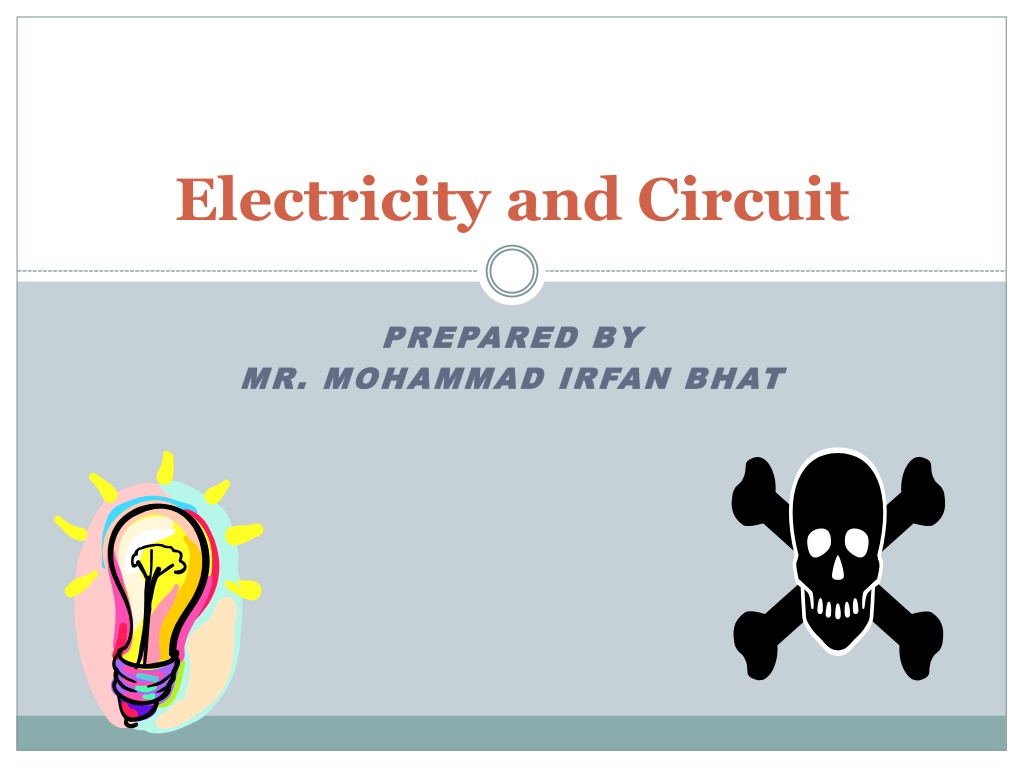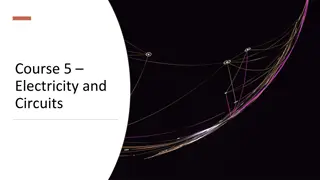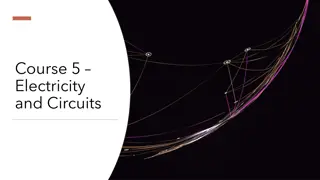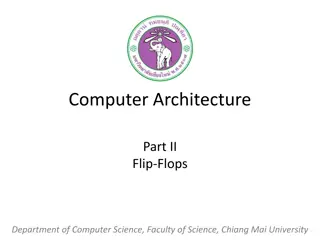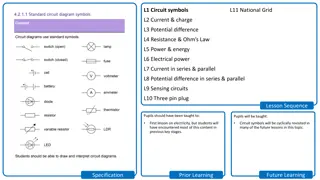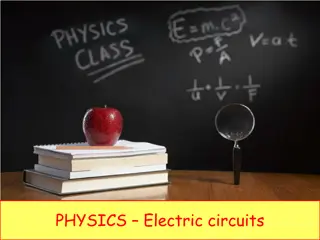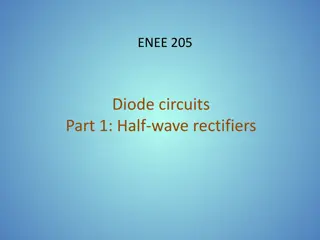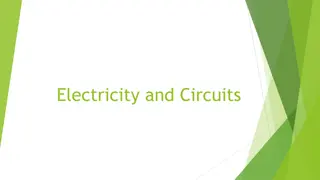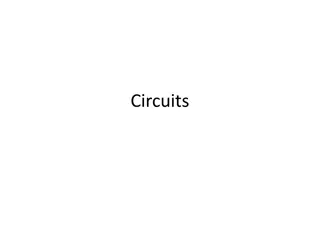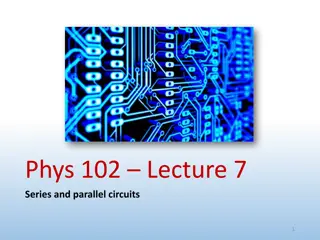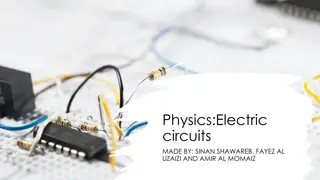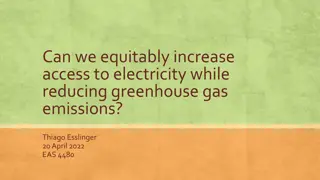Electricity and Circuits: Basics and Components
Delve into the world of electricity and circuits with this comprehensive lesson. Learn about electric cells, bulbs, wires, switches, conductors, and insulators. Explore how electricity flows, the components of an electric circuit, and the production of electricity in cells. Discover the construction and working of electric bulbs and torches, along with the history and fundamentals of electricity. Enhance your knowledge and understanding of this essential aspect of modern technology.
Download Presentation

Please find below an Image/Link to download the presentation.
The content on the website is provided AS IS for your information and personal use only. It may not be sold, licensed, or shared on other websites without obtaining consent from the author.If you encounter any issues during the download, it is possible that the publisher has removed the file from their server.
You are allowed to download the files provided on this website for personal or commercial use, subject to the condition that they are used lawfully. All files are the property of their respective owners.
The content on the website is provided AS IS for your information and personal use only. It may not be sold, licensed, or shared on other websites without obtaining consent from the author.
E N D
Presentation Transcript
Electricity and Circuit PREPARED BY PREPARED BY MR. MOHAMMAD MOHAMMAD IRFAN MR. IRFAN BHAT BHAT
OBJECTIVES OF THE LESSON:- THE STUDENTS WILL KNOW ABOUT ELECTRIC CELL AND ITS USES. THE STUDENTS WILL KNOW ABOUT ELECTRIC BULB, WIRE ,ELECTRIC SWITCH AND ITS WORKING THE STUDENTS WILL BE ABLE TO KNOW ABOUT CONDUCTORS AND INSULATORS AND THEIR USES.
LEARNING OUTCOMES:- STUDENTS WILL BE ABLE TO: LIST THE USE OF ELECTRICITY USING DIFFERENT ARRANGEMENTS OF CELL,WIRE AND BULB AND SHOW HOW AN ELECTRIC CURRENT IS PRODUCED EXPLAIN THE CONSTRUCTION AND WORKING OF: a)Electric Bulb b)Electric Torch
INTRODUCTION The study and using of electricity is relatively new. Scientists only began understanding electricity in the late 1800s. Scientists first believed electricity was cause and by two fluids in an object. They now know that it is not fluid, but positive and negative charges of an electrical energy in an object.
ELECTRICITY (It is flow of an electric current) ELECTRIC CURRENT Flows around Stopped by Carried by ELECTRIC CIRCUIT CONDUCTORS INSULATORS
Electric Cell Electric cell is a source of electricity. Production of electricity in cell : An electric cell produces a small amount of electricity from chemicals stored inside it. When the chemicals in the electric cells are used up, the electric cells stop producing electricity. Terminal: All types of electric cells have two terminals, a positive terminal and a negative terminal. In a day cell used in our homes, the central carbon rod is the positive(+) terminal and the zinc contained is the negative(-)terminal
Continued.. Battery: When two or more cells are joined together, the combination is called a battery. +ve Two electric cells joined together +ve
Types of Terminals: All types of electric cells have two terminals, a positive terminal (+ve) and a negative terminal (-ve). In a dry cell used in your homes, the central carbon rod is the positive terminal (+) and the zinc contained is the negative (-) terminal.
Bulb Bulb : We get light from a thin tiny wire inside the glass cover. This is called filament. It is supported by two thicker wires, as shown in Fig. One of these thick wires is connected to the metal casing around the base of the bulb. The other is connected to the metal tip of the base. The base of the bulb and the metal tip of the base are the two terminals are fixed in such a way that they do not touch each other. The inside portion of the bulb is filled up with inert gases, like argon.
An Electric Circuit Circuit: The complete path, from one terminal of the electrical cell through the bulb and back to the other terminal of the electric cell, is called a circuit. Open circuit: If there is any gap in the path of a circuit, the bulb does not light up. Such a circuit is called an open circuit. Closed circuit: The bulb lights up when bulb and wire from a complete path, which starts at one terminal of electric cell and ends at the other terminal. Such a circuit is known as closed circuit.
Types of Circuit Open Circuit Connecting wire is missing Closed Circuit No source of electrical energy Electric Cell Connecting Wires lightbulb
Flow of current in circuit The path from one terminal of electric cell to the other is completed, an electric current starts flowing through the circuit and the bulb lights up. The electric current flows from the positive terminal of the electric cell to its negative terminal.
Continued.. In the bulb, current enters through one terminals, flows through the filament inside the bulb and comes out through the other terminal of the bulb. When the current flows through the filament, it starts glowing. Fused bulb: If the filament of the bulb is broken, the circuit is not completed and hence the current cannot flow. The bulb with broken filament is called a fused bulb. When a bulb gets, fused, it does not light up.
Electric Conductors and Insulators Conductors: Materials through which electric current can flow are called conductors. Most metals are conductors. Our body is also a good conductor. Insulators: Materials, through which the electric current cannot pass ,are called insulators. Insulators are the bad conductors of electricity. Rubber and wood are insulators.
Conduction tester It is a simple device to test whether a material is a conductor or insulator.
Contned.. Filament: The thin wire that gives off light is called the filament of the bulb. Dry Cell: A dry cell is usually made of metallic cylinder. It has a flat base and a metallic cap on top. The metallic cap on top is the positive (+) end of the cell. The flat base is the negative (-) end of the cell. A cell usually produces 1.5 V of current. Bulb : An electric bulb is a device which glows and emits light, when electric current is passed through it.
Electric current Most of the devices and machines we use like an electric icon, oven, room heater, refrigerator, ceiling fan or an electric bulb work when an electric current flows through them. Source of Electric current: A device that can be used to produce an electric current is called a source of electric current. Common sources of electric current are cells and batteries (collection of cells) which comes in various shapes and sizes(Fig. 14.2),and electric current that we get from plug points in houses.
Different source of electric current Different types of cells and batteries
Flow of Electric Current Three basic conditions are required for an electric current to flow. A device used to produce an electric current like cell, battery ,or a plug point acting as a source. A wire made of a metal like copper, silver, or aluminium , which will allow electric current to flow through easily. An unbroken loop(of the wire) running from one terminal of the source, through various appliances, Back to the other terminal of the source.
Electric Switch Electric switch: Electric switch is a simple device that either breaks the circuit or completes it to stop the flow of current. When the switch completes the circuit, it is called switch. When the switch breaks the circuit, it is called open switch.
Electric Switch We use electric switches .to put on or off the electrical devices and machines. But do you know how it works? An electric switch is a device that is used to open or close an electric circuit.
Torch A torch is made up of a cylindrical or cubical casing. The casing can be metallic or non-metallic. The cells are kept inside the casing. The bottom of the casing has a spring which is attached to the metallic wire. The spring helps in keeping the cells snugly fit in place. The metallic wire is attached to a switch. The switch is then attached to terminal of the holder. The positive end of the holder touches the positive terminal of the cell at top. The bulb fits inside the holder. the negative
Fill in the blanks: A device that is used to break an electric circuit is called . Answer: Electric switch An electric cell has .terminals. Answer: Two
Mark True or false for following statements: Electric current can flow through metals. Answer: True Instead of metal wires, a jute string can be used to make circuit. Answer: False Electric current can pass through a sheet of thermocol. Answer: False
Answer the following questions Explain why the bulb would not glow in the arrangement shown in the given figure? Answer: The following reasons are possible: The connections may be loose. The bulb may have fused. The energy of cell may have sapped.
Answer the following questions Complete the drawing shown in the given figure to indicate where the free ends of the two wires should be joined to make the bulb glow. Answer:
Answer the following questions What is the purpose of using an electric switch? Name some electrical gadgets that have switched built into them. Answer: An electric switch helps us in making or breaking the electric circuit as and when required. It helps in saving electricity and in prolonging the life of an electric cell. Table fan, transistor, mixer-grinder, television, etc. are some gadgets which have inbuilt electrical switches. Would the bulb glow after completing the circuit in figure if instead of safety pin we use an eraser? Answer: If an eraser is used instead of a safety pin to complete the circuit, the bulb would not glow. Eraser is an insulator and hence it would not allow electric circuit to become complete.
Answer the following questions Would the bulb glow in circuit shown in the given figure? Answer: No, because both the wires are attached to the negative pole of the bulb.
Answer the following questions Using the conductiontester on an object is was found that the bulb begins to glow. Is that object a conductor or an insulator? Explain. Answer: The object is a conductor which is proved by electric circuit becoming complete. Why should an electrician use rubber gloves while repairing an electric switch at your home? Explain. Answer: Rubber is an insulator and thus does not allow electric current to pass through it. When an electrician repairs an electric switch, he may get electric shock because leakage in electric current. Rubber gloves prevent him from getting electric shock. Hence, an electrician wears rubber gloves while repairing something. The handles of the tools like screwdrivers and pliers used by electricians for repair work usually have plastic or rubber covers on them. Can you explain why? Answer: Plastic is an insulator. The plastic handles on screwdrivers and pliers; used by electricians; help in preventing accidental electric shock.
Thankyou THE END.
